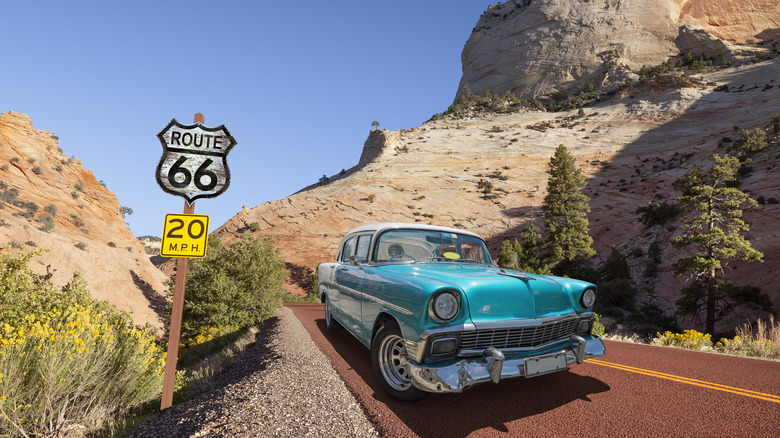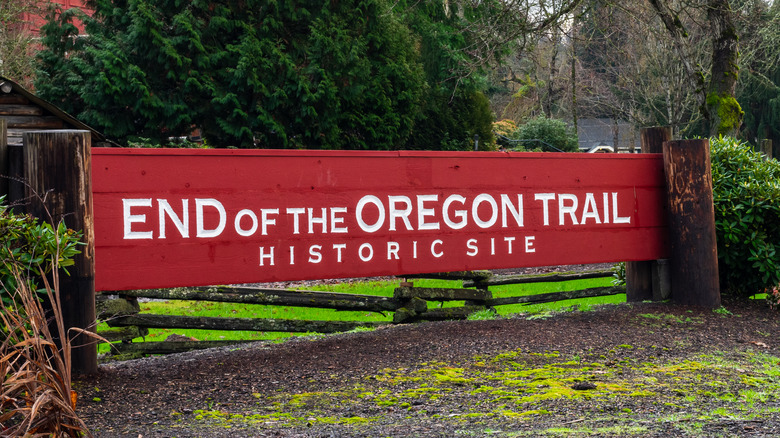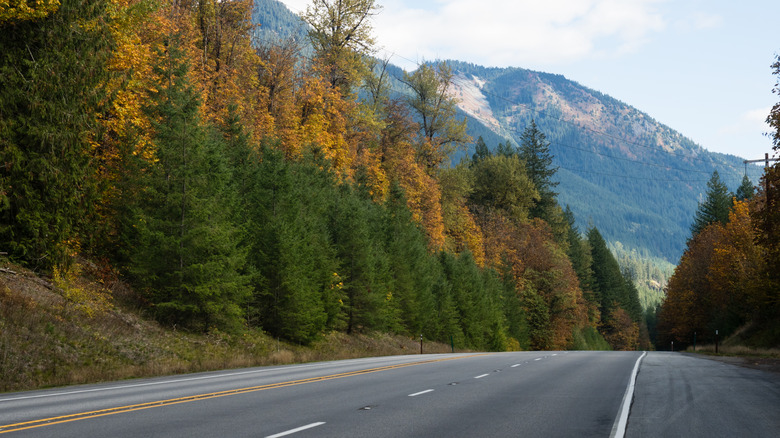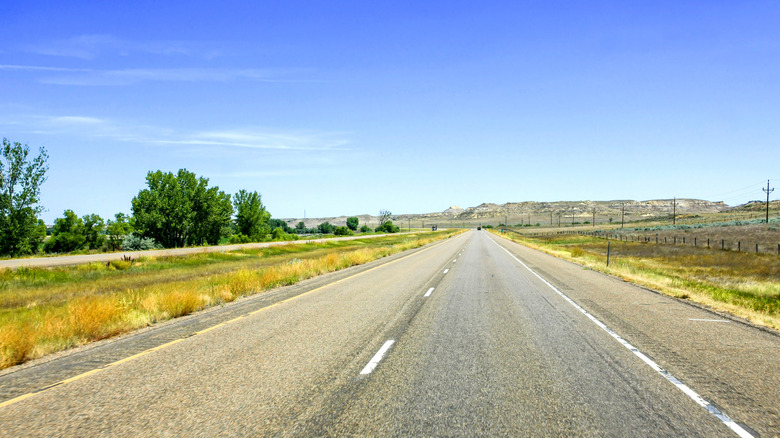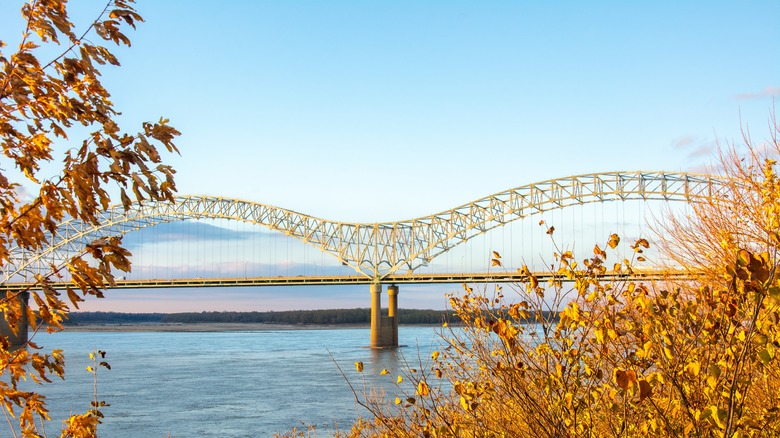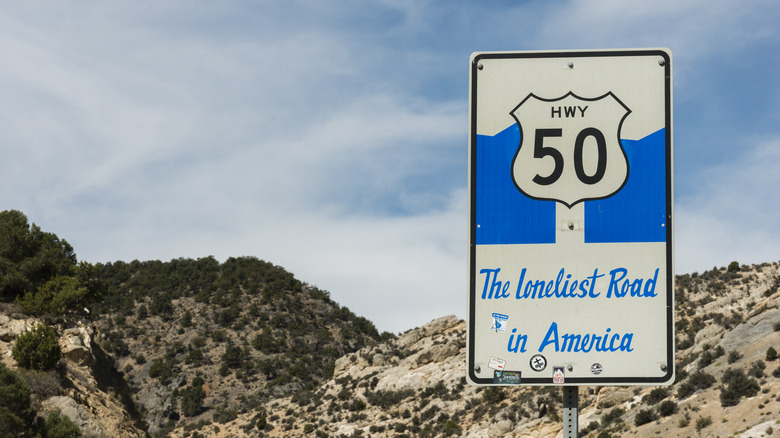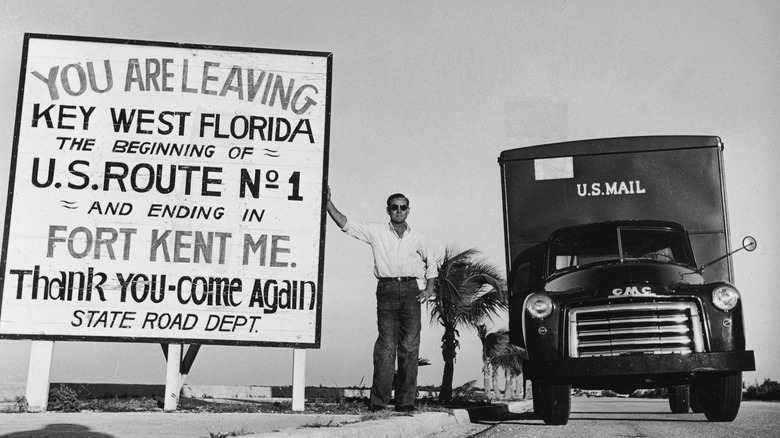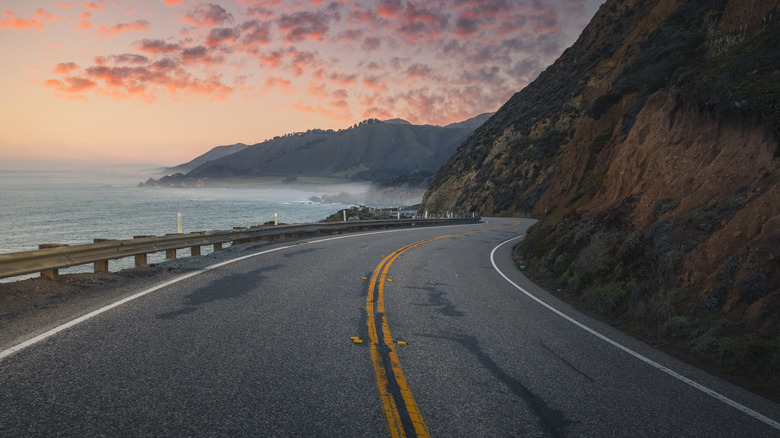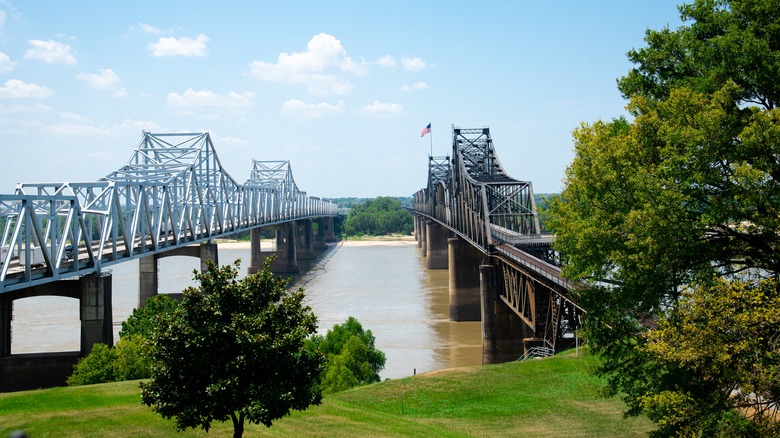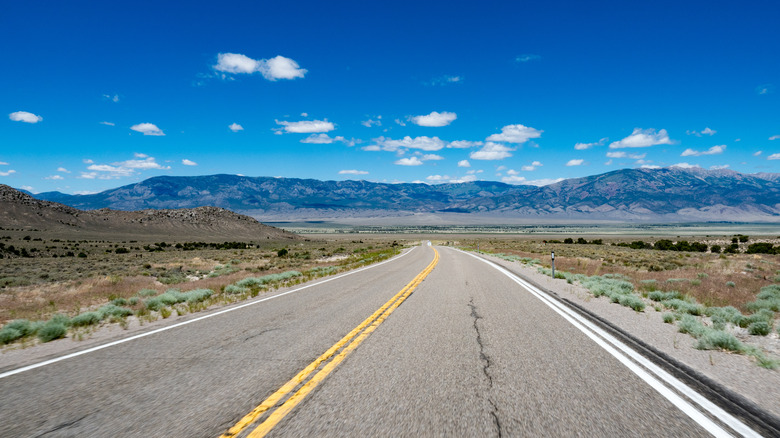Incredible US Road Trips That Deserve A Spot On Your Bucket List
The road trip is an essential part of the American character. Our desire to explore stretches back to the founding days of the country, and has been typified in over the centuries by iconic roadways like The Oregon Trail, Highway 50, and, of course, Route 66. With summer just around the corner, we want to take a deep dive into some of the incredible road trips you can take in this country, and tell you exactly why they deserve a spot on your bucket list.
According to BusinessWire, a shocking 70% of Americans prefer driving over flying than they did only a year ago. A lot of this is chalked up to frustrations with airline cancellations, delays, travel stress, and safety concerns. Gen Z, in particular, is hitting the road more and more due to its accessibility, affordability, and bonding time with friends and family. So why not use vacation time to take some of the best Blue Highways in the US and see the wonders of the country?
Whether you're heading north to south, east to west, or the opposite of each, these 10 incredible road trips are pure Americana. No matter what kind of car you have, we guarantee you will find something to love about these amazing roadways.
Get your kicks on Route 66
Anyone who has seen Pixar's "Cars" knows that Route 66 is the American roadway. Commissioned in 1926 as a way to connect Chicago and Los Angeles with a single road, Route 66 became an icon thanks to clever and aggressive marketing from the Route 66 Association as the route to the "promised land" during the Dust Bowl of the 1930s. Though it is a decommissioned highway today, there are still plenty of people who flock to Route 66 to partake in this nostalgic American road trip.
Slicing across the country in a diagonal, the route is 2,488 miles long and passes through some of the more far flung corners of the mid and southwest. This includes places like Tulsa, Oklahoma, Amarillo, Texas, and Flagstaff, Arizona. Ghost towns, formerly iconic motels, and roadside attractions like the Second Amendment Cowboy litter Route 66, giving drivers a unique sense of a bygone era.
The trip can easily be split into sections of several hundred miles if you can't manage the whole route. Albuquerque, New Mexico is the best starting point for those seeking the southwestern desert scenery associated with Route 66. Efforts to revitalize the route, including grants from the National Trust for Historic Preservation, are well under way, so it could very well see glorious days Chuck Berry once sang about in his famous song.
Head west on the Oregon Trail
The historic Oregon Trail is the single most important road in American history. Route 66 may be more iconic, but it's the Oregon Trail that brought about the single largest, land-based, mass migration in United States history. For 20 years, between 1840 and 1860, around 400,000 travelers made the 2,000-plus mile journey from Independence, Missouri towards the promise of prosperity in the west. Today, the majority of the route is paved, and no one travels it in canvas covered wagons... that we know of, anyway.
Taken at a leisurely pace, the 3,300 miles of the modern Oregon Trail take you westward, or eastward, from coast to coast. Starting in Cape Cod on the eastern edge of Massachusetts, the road passes through some of the most beautiful and historically significant areas in the US. These include Lexington and Concord, the Baseball Hall of Fame, Niagara Falls, the Field of Dreams, Mount Rushmore, and Yellowstone National Park — which is a wonderful spot for freshwater fishing.
Though very little of the new Oregon Trail retraces the original, the stretch over the Cascade Range and into Columbia Gorge gives you an idea of the scenery those early travelers must have witnessed. The new route still provides that immense sense of scale and history, and provided modern travelers with a newfound appreciation for those intrepid 19th century travelers.
Wave to Canada along the Great Northern
The Great Northern embodies the essence of the northern U.S. character. For 2,575 miles, travel along Route 2 and traverse the northern crest of the country along the Canadian border. From the Green Mountains of Vermont, Mackinac Island State Park in Michigan, the wilds of Idaho, to the metropolitan charm of Seattle, the Great Northern is one trip no lover of northern scenery will want to miss.
One important thing to note about this route is the fact that you are going to have to pass through Canada to get from Vermont to Michigan. You enter via the border by Burlington, Vermont, travel through Quebec and Ontario, then cross back over into the USA at St. Ignace, Michigan. The scenery along the Canadian side of the Great Lakes is some of the most beautiful on the continent.
The time of year you go is important for enjoying this road trip. Late spring, summer, and early fall are the best times to go, as they offer you the best weather, and the most bang for your buck as far as availability of sites. Winter is doable, but not advisable for this road trip because of the fact that all of the states you'll pass through get good amounts of snow, and many tourist attractions are closed for the season.
Are you really on the Road to Nowhere?
As the first paved road from Canada to Mexico, the Road to Nowhere is appropriately named despite its place in history. A virtual straight shot from the Canadian border in North Dakota to the Mexican border in Texas, the Road to Nowhere follows U.S. Route 83 for 1,885 miles of flat plains, farmland, small towns, rolling grasslands, and raging rivers. While the scenery may seem monotonous at times, which is likely what gave rise to the route's moniker, there is reason enough to take this trip for the sole reason of it being relatively tourist-free.
While iconic routes like Route 66 and the Great Northern cut through a lot of the most famous landmarks in the United States, Route 83 cuts through no tourist hubs whatsoever. Now, for folks looking for a more quiet road trip, this is likely perfect. Getting to know the locals at small diners, or enjoying "Wizard of Oz" themed OzFest in Liberal, Kansas, the Road to Nowhere is probably the only road trip on this list that gives a truly unfiltered look into rural middle America.
While many deem this to be "fly-over nation," those who travel the Road to Nowhere might find somewhere worth visiting. So if you're not one for crowds, traffic, or traditional tourist destinations, why not travel down this lesser-visited American roadway and see the oddities of this vast land for yourself.
Wind your way down the Great River Road
The Mississippi River is the most remarkable and iconic (gosh, we're using that word a lot) river in the United States. Everyone knows the Mississippi. It has served as a lifeline for countless cities and towns as a means of trade and transportation. The importance of this river to American history, past and present, cannot be understated. Appropriately, the Great River Road pays tribute to this legacy by winding drivers down the entire length of the Mississippi River.
Starting in the wilds of northern Minnesota, the Great River Road follows the Mississippi southward towards its terminus at New Orleans, Louisiana. First began in 1938 as a conglomeration of routes between 10 states, the Great River Road was designed to show off the river, and local character of the towns that dot the riverside. It's a far cry from interstate travel, as you'll be meandering down 3,000 miles worth of road, and criss crossing the river whenever possible.
The route itself is the destination of this trip. The scenery of cypress swamps, grasslands, and fertile delta can rival that of any dramatic ocean coast. Add to that the unique city destinations like Memphis, Tennessee and the ever vibrant New Orleans, and you have yourself an amazing trip that is Americana at its finest!
The Loneliest Road? Not with friends!
If you're for solo adventuring, the fact that you're road tripping alone won't bother you. However, even the most maverick of soloists has to admit to loneliness on the road once in a while. This needn't be the case. A road trip is never lonely when one has friends, even on the self-proclaimed Loneliest Road in America. Much like the aforementioned Road to Nowhere, the Loneliest Road in America does live up to its name in certain areas. It is not, however, totally remote.
While there are definitely places along this famous route that feel so empty you'll wonder if you'll ever see anyone again, the feelings of total loneliness are dashed when you stop at any one of the fantastic destinations along this 3,000 plus mile route. Nicknamed "The Loneliest Road in America" in a 1986 issue of Life Magazine, Highway 50 stretches from Maryland to California, passing through desert, mountains, great plains, Civil War battlefields, and the Golden Gate Bridge.
Built as a way to connect the coasts, the route was more often traveled before the invention of the Interstate Highway System. Owing to its length, the trip can be experienced in chunks you've got limited time. However, you won't get that same cross country experience as you would if you did the entire stretch.
You get both pines and palms on Route 1
If you've ever wondered if there was one road that ran the entire length of the East Coast, all the way from Florida to Maine, then you really need to check out Route 1. From pines to palms, this epic 2,369 mile journey down (or up) the Atlantic Coast is one of the best ways to see some of the country's major cities. Though rural in some spots, Route 1 encapsulates the entirety of the northeast megalopolis, making it perfect for anyone who loves ocean views and city culture.
You can choose to begin the journey either in Key West, Florida, or Fort Kent, Maine. Either way you go, you'll be passing through some of the most historically significant places in the country, including Boston, New York City, Washington D.C., and so many more. It's impossible to capture just how many places you could see. You could take an entire month to travel Route 1 and still not see everything.
Now, if you're not one for traffic and high volume tourist destinations, certain sections of Route 1, particularly those between Boston and D.C., might not be for you. However, the southern stretch is more open and shows off some amazing, sparsely visited coastal and inland scenery of southern states, before opening back up to more vast ocean along the famous Seven Mile Bridge to the Florida Keys. Overall, an unforgettable driving experience.
From rainforest to desert on the Pacific Coast Highway
Almost the mirror image of Route 1, the Pacific Coast Highway runs the length of the west coast from Seattle, Washington, all the way down to San Diego, California. It's rainforest to desert on this famous 1,650 mile route, a lot of which is a whole lot more rural and scenic than people think. Naturally, when traveling down the west coast, you will encounter pockets of urban sprawl, especially between L.A. and San Diego. However, the Pacific Coast Highway is far more rural and scenic than its eastern sister, especially if you begin your journey in Washington state.
Out from Seattle, the Pacific Coast Highway turns towards the Olympic Peninsula. Here, at the far western corner of the lower 48, the route winds through the dramatic Olympic National Park, showcasing breathtaking mountains, coasts, and glaciers. Farther southward in California, the famous Avenue of Giants showcases the enormous Redwood trees, and the incredibly dramatic Big Sur coastline.
Vibrant cities like Seattle, Portland, San Francisco, and Los Angeles, popular beaches, and the famous Hearst Castle dot the highway, making for pleasing cultural breakpoints between the vast open spaces along the coast. Overall, you'd be hard-pressed not to find something to like about this road trip.
The Southern Pacific from Georgia to California
The Southern Pacific sounds more like traveling through a string of islands in the southern Pacific Ocean than it does a tour across the continental United States. Yet, the latter is exactly what this is. One of the oldest official roadways on this list, the Southern Pacific was originally created in 1914 as the Dixie Overland Highway. As it follows Route 80 from Georgia throughout the entirety of the South and into the deserts of southwest before reaching the Pacific ocean at San Diego, the new Southern Pacific name is more apt.
Perhaps the most foodie-oriented of all the trails, the Southern Pacific takes you through the heart of American barbecue country. Be sure to stop by roadside stands in Texas, Alabama, Mississippi, and Louisiana. The allure of the authentic taste of southern barbecue will have your mouth watering before you've even gotten out of the car.
Further west, you encounter such fascinatingly different sites as Roswell, New Mexico, with its strong UFO theme, and Tombstone, Arizona, which is the postcard for a 19th century wild west town. Overall, this 2,734 mile trip takes you from swamps and bayous, to desert, cacti, and the blisteringly beautiful ocean coast. It's certainly not a trip to be missed.
Border to Border in either direction
This final incredible road trip on our list technically begins in Canada. Starting at Jasper National Park in Alberta, this route, appropriately nicknamed Border to Border, is an amazing 2,245 mile trip southward through the majesty of the Rocky Mountains and into the vast deserts of Arizona and Nevada. The scenery is unparalleled in its beauty, with sunsets reportedly being some of the most stunning in the entire country.
Once out of Canada, drivers pick up U.S. Route 93, and continue southward on that for the rest of the trip. It's recommended that trippers take 10 days to properly enjoy the trip, which begins its U.S. leg in the wilds of Montana and Idaho, before breaking into the cactus forests and red sandstone cliffs of Nevada. From Las Vegas, the road crosses over the Hoover Dam and into Arizona, where it ends at the town of Nogales, right on the border with Mexico.
The need to drive is strong in this country. It's why road trip movies do well at the box office, and why American car culture is among the most iconic in the entire world. The United States is enormous, and the best way to see it is to drive through it. Take your time and truly take in what these amazing roads have to offer.

